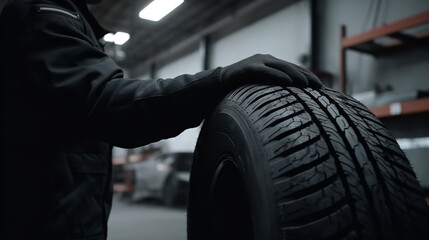
A wheel is a metal component that holds a tire. It converts engine power into a spinning motion that propels the vehicle. The tire provides traction to keep the vehicle stable on the road.
The raw materials required to make tires include oil and steel. The process of extracting these elements negatively impacts the environment by generating greenhouse gases and toxic air pollution.
When shopping for tires, the brand you choose is just as important as the size. This is because the tire plays a critical role in your car’s handling and performance. The wrong tire can negatively impact your vehicle’s fuel efficiency, traction, and ride quality. With so many different tire brands and types on the market, it can be overwhelming to know what is right for your vehicle.
To make the buying process easier, we recommend reading your vehicle’s owner’s manual or comparing the current tires on your car to the list provided by the manufacturer. This way, you can be sure to get the right tire for your car or truck. The type of tire you choose is determined by the needs and driving environment of your area. The most common tire types include passenger car tires, light truck tires, and SUV tires.
During the time when bicycles used natural rubber, tire makers were developing better pneumatic tires. These early tires consisted of an inner tube that was inflated and protected by an outer casing that was pressurized. The inner tube was enclosed by layers of woven fabric and natural or synthetic rubbers known as plies.
Modern tires use much more complex laminate structures to achieve their performance goals. Extensive engineering involving computer simulation, real-world testing, and trial and error goes into their construction. The information branded on the sidewall of your tire provides a glimpse into what goes into the making of every new tire you see on the road.
The first letter in the tire size code tells you what type of vehicle the tire is designed for. If the code begins with a “P,” it stands for “passenger vehicle” tires, which are typically fitted to cars, minivans, and some smaller pickup trucks. Tires with an “LT” are made for vehicles capable of towing trailers and have higher psi recommendations. Tires with an “ST” are for trailer wheels and have special requirements.
The remaining letters in the code indicate what kind of tire it is and the speed rating. A “R” indicates the tire is radial, which means the layers of material are positioned radially around the circumference of the tire. The two digits that follow the “R” indicate the aspect ratio, which is the ratio of the height of the tire’s cross-section to its width. The higher the number, the bigger the tire.
Style
The tires on your car are much more than just a black ring of rubber. They’re complex pieces of engineering that are designed to tackle a variety of different challenges on the road, giving your vehicle superior handling and traction. But which tire is the right one for your needs? Read on to learn more about the different types of tires and how they can help your vehicle perform at its best.
The first thing to understand are the different parts of a tire and how they work together. The wheel, or rim, is the metal portion that holds the tire and connects it to your vehicle’s suspension and steering systems. The tire is the black rubber part that contacts the road and is connected to the rim with lug nuts.
While the outside of the tire may look smooth and flat, there’s a steel mesh design inside that helps make the tire tough. The internal structure also allows the tire to retain air and provide traction even under stress.
There are five main types of tires:
All-season tires are the most common type for passenger cars and light trucks and are designed to offer a smooth ride, reliable all-season traction, and a long tread life. For a sportier feel, you can upgrade to performance tires for extra grip on the road and reduced road noise.
Another important factor to consider is the load index, which tells you how much weight a tire can support. You can find the load index number by looking at the tire size sequence. Passenger car tires will have a “P” or “Euro-Metric” before the size, and LT-Metric or Euro-Metric commercial (C-Type) tires will have two numbers separated by a slash:
The second number in the tire size sequence tells you how tall the sidewall is. The last number indicates the diameter of the wheel rim that the tire should mount on, in inches. The last letter in the number sequence refers to the internal construction of the tire. R indicates radial ply construction, which is the standard for most tires today. It’s a newer design that provides better road grip, lower rolling resistance for improved gas mileage, and a longer tread life. Bias-ply tires, which have diagonal (crisscrossed) plies, are sometimes still used in some applications.
Material
The tires on a vehicle are made from rubber, a non-renewable resource. Rubber is a tough material that can absorb a lot of damage from bumps, rocks, and other road debris while providing traction and handling. Early tires were bands of leather or iron (later steel) that a skilled worker would place around wooden wheels on carts and wagons. When they got damaged, the wheelwright would heat them up to expand them and then quench them, which caused them to shrink back down to their original size so they could fit tightly onto the wheel. The problem was that once the tire was damaged, it would be very expensive to replace the wheel and tire and even more difficult to find a replacement at a reasonable cost. A better solution was needed.
Today, tires are manufactured in molds to give them their round shape. The rubber is vulcanized with chemicals and heat to make it stronger and more resistant to heat and abrasion damage. Fabric cords such as nylon, rayon, and aramid help reinforce the tire and improve its elasticity. Steel wire is used in the tread, in belts for passenger tires, and in bead wire for truck tires to stiffen the casing and improve wear performance and handling. Fillers like carbon black and silica improve properties such as abrasion, tear, and rolling resistance.
Tires also have a tread design that determines how well they grip the road and how long they last before wearing out. Tread materials vary, with some having special additives to improve performance in wet or dry conditions. Some have a hard compound that stays flexible in low temperatures, while others have soft compounds to provide top performance even when it’s cold.
Most tires have a code on the sidewall that denotes size, rating, and other information. The first two numbers on the right of the slash symbol indicate the aspect ratio, or the percentage of the tire’s height as it relates to its width. The letter in the middle is the construction type, most often R for radial.
Warranty
Although most tires are manufactured with the highest level of quality control, there is always a risk that a tire will be defective or cause excessive vibration. Most manufacturers account for this by offering a uniformity warranty that covers the replacement of a defective tire if it is reported within the first 2/32nds of tread wear. This is a good reason to hang onto your purchase receipt and to keep up with routine maintenance like regular rotations and alignments.
Another common type of tire warranty is a road hazard warranty, which protects your investment by covering repair or replacement costs in the event of damage from a road hazard. This type of warranty typically covers a year or the first 2/32nds of tread, whichever comes first, and includes tire replacement plus appropriate taxes, mounting, balancing, and disposal fees.
In addition to these warranties, some tire companies also offer mileage warranties that promise to replace a tire if it doesn’t make it to the end of its expected life or if it wears through more than a certain amount of tread. These types of warranties are an excellent option if you drive a lot and don’t want to be stuck with an expensive replacement bill.
Some manufacturers even offer a trial period for tires where you can exchange them for another set of their own products if you don’t think they are right for your car. This is similar to the way many companies sell auto insurance, so you don’t have to pay for the whole thing up front.
In addition to these manufacturer’s special warranties, third-party extended tire and wheel warranty plans are available. These plans can help offset some of the unexpected costs associated with owning a car and may be especially helpful for those purchasing used or leased vehicles. However, these plans should be considered carefully before you buy them because they can come with terms and conditions that limit their effectiveness. For example, some plan policies will only cover cosmetic damage to wheels and tires from things like potholes, nails, and curb rash and will not reimburse you for anything that is pre-existing.
